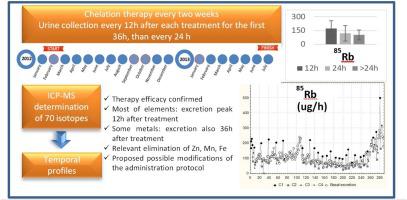Journal of Trace Elements in Medicine and Biology ( IF 3.5 ) Pub Date : 2020-08-14 , DOI: 10.1016/j.jtemb.2020.126608 Elisa Robotti 1 , Fabio Quasso 1 , Marcello Manfredi 2 , Fabio Gosetti 3 , Eleonora Mazzucco 4 , Ciro Isidoro 5 , Emilio Marengo 1

|
Background
Based on the medical history and laboratory analytical tests, a patient presenting symptoms compatible with Chronic Fatigue Syndrome was suspected of metal intoxication; therefore, a chelating therapy was attempted. In parallel, the profile of elemental excretion in urine was determined.
Methods
Chelation therapy by CaNa2EDTA was administered every two weeks and urine samples were routinely collected for 17 months. The samples were mineralized with HNO3 69 % and analyzed by Inductively-Coupled Plasma – Mass Spectrometry. Data were processed by multivariate statistical methods.
Results
Most of the toxic elements showed a peak of excretion in 12−24 h after EDTA administration, which returned to basal level by 24−36 h after the treatment. Yet, the excretion of some trace elements persisted in the urine collected 26 h after the treatment.
Conclusions
The analysis of excreted metals following the CaNa2EDTA infusion allowed to monitor dynamically the chelation therapy. The chelation therapy was effective in mobilizing and eliminating the principal heavy metals present from the body. However, since such clearance almost vanished 24 h after the treatment, a protocol with more frequent and low-dose administrations is advisable to improve the metal excretion.
中文翻译:

ICP-MS 测定和 EDTA 螯合治疗期间元素尿排泄特征的多变量数据分析:案例研究。
背景
根据病史和实验室分析测试,一名患者出现与慢性疲劳综合症相符的症状,怀疑金属中毒;因此,尝试了螯合疗法。同时,测定了尿液中元素排泄的特征。
方法
每两周进行一次CaNa 2 EDTA螯合疗法,并在 17 个月内定期收集尿液样本。样品用 HNO 3 69 %矿化,并通过电感耦合等离子体质谱法进行分析。数据通过多元统计方法处理。
结果
大部分有毒元素在 EDTA 给药后 12~24 h 出现排泄高峰,24~36 h 后恢复至基础水平。然而,治疗后 26 小时收集的尿液中仍有一些微量元素的排泄。
结论
CaNa 2 EDTA 输注后排泄的金属分析允许动态监测螯合疗法。螯合疗法可有效调动和消除体内存在的主要重金属。然而,由于这种清除在治疗后 24 小时几乎消失,建议采用更频繁和低剂量给药的方案来改善金属排泄。



























 京公网安备 11010802027423号
京公网安备 11010802027423号